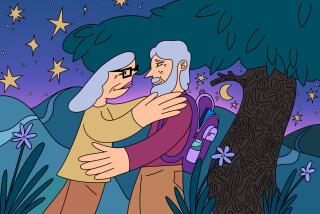Volunteers Befriend Psychiatric Patients
- Share via
ROCHESTER, N.Y. — Tim Cassidy lives a mostly solitary life. Alone in his studio apartment, planted in his armchair, he’ll spend an entire weekend watching television. Heading out to his part-time clerical job, he may greet a neighbor in the hallway with little more than a polite hello.
And when his case manager calls, it’s strictly business, the 37-year-old Cassidy said with a shrug. “We don’t go out to the movies or anything.”
But Cassidy, a former Navy seaman’s apprentice who suffers from schizophrenia, is not entirely on his own. He has a friend in David Miller, 41, a volunteer who’s been coming by for a few hours every couple of weeks for the last 12 years.
Often they’ll go to a hockey game, catch a movie or set off hiking. The day frequently wraps up with an exuberant family meal with the Millers and their three children. “I look forward to going out with Dave. When he calls, I’m excited,” Cassidy said with sudden emphasis, as if rousing himself from a stupor.
Cassidy has lost years of his life to mental illness. He’s inching back with the help of sophisticated drugs, community-based housing and a national organization called Compeer Inc., which enlists volunteers to befriend people with psychiatric disorders.
Breaking through the social isolation that commonly accompanies mental illness can be a crucial step on the bumpy road to recovery.
“It’s the loneliest illness in the world,” said Bernice Skirboll, who launched Compeer in 1977 and draws on 5,000 recruits in 30 states. “People are feeling so down about themselves, like they’re not worth anything.
“If you have friends who support you and nurture you, you can overcome any obstacle, whatever curves life throws you. We have incredible outcomes. People begin to believe in themselves; they increase their risk-taking.”
Dan Fisher, a psychiatrist in Lawrence, Mass., once stricken with schizophrenia, thinks isolation is a primary trigger in mental illness. In his case, he said, a crucial factor in recovery was “having a significant social role, being accepted and accepting oneself as a member of a community one lives in.”
Compeer emerged when severely ill adults were leaving psychiatric institutions in droves, the result of a switch in emphasis to community care. “My goal was to make them less dependent on the institution by making the community a friendlier place,” Skirboll said.
Nonetheless, stigma and discrimination remain pervasive.
“Mental illness has not come out of the closet like cancer or AIDS,” she lamented. “We’ve been looking for a national spokesperson for years. We’ve written to a lot of celebrities.”
Cassidy was diagnosed at age 20 with schizophrenia, an illness typified by disordered thinking. His grip on reality came loose during an eight-month cruise. Lying on his bunk, he began hearing voices and seeing visions of “people and shadows and things.”
Recounting his four-year odyssey through hospitals and psychiatric wards doesn’t appear easy for him, as if the illness has blurred his memories. But the locked doors, the strictness, the absence of good food are vivid. “I had my share of cereal,” he joked.
Most days, he still sees “dark lines” on his apartment floor. Periodically, he gets an uncomfortable feeling he’s about to step on someone. Dislocated voices sometimes issue commands, but they’re no longer negative, he said.
Schizophrenia affects, in varying degrees, about 1% of Americans. With science opening up understanding of brain disorders long considered intractable, two-thirds of sufferers live functional lives.
Cassidy takes Clozaril, an antipsychotic drug that keeps his demons at bay. He is still prone to bouts of lethargy, dread and depression, and may begin taking an additional medicine.
A stocky man, Cassidy recently went shopping with Miller for a bicycle. Besides providing much-needed exercise, it will take him across town to play miniature golf, his favorite pastime.
Cassidy’s mother, Joan Welch, helps with shopping, drives him to work when he feels so sluggish he wants to quit, and prods doctors to try more effective treatments.
“I’ve always been his advocate,” she said. One of Cassidy’s six siblings also helps out.
Under a community residence program run by Rochester’s East House, Cassidy first lived in a group home with a dozen other mentally ill people. He progressed to living with a roommate and then got his own place in 1997.
“Each step is better for me,” he said, although the $490 rent leaves little for luxuries. He earns $60 a month at his job, and so he relies on Social Security and food stamps.
His friend Miller, a manager at a textile company, said, “All of us experience depression or loneliness or some type of mental illness from time to time. . . . Some of us pull out of it differently than others.”
In the Compeer program, Miller receives periodic training that emphasizes building up interdependence in people who, after years of inwardness, have lost social skills and contacts.
“I always look forward to seeing Tim,” Miller said. “The first couple of years, our visits were quiet. But as we’ve gotten more comfortable and sillier with each other, we spend more time talking.
“The friendship helps me slow down and keeps me focused on the most important things in my life too. I . . . can begin to imagine walking a mile in [Tim’s] shoes.”
More to Read
Sign up for Essential California
The most important California stories and recommendations in your inbox every morning.
You may occasionally receive promotional content from the Los Angeles Times.













